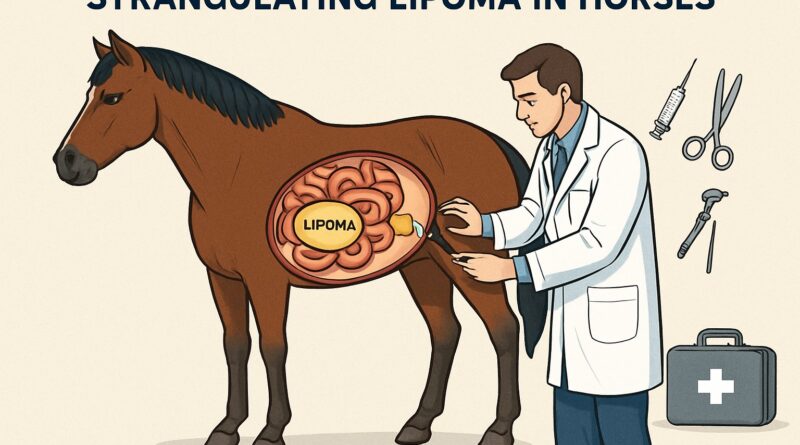Strangulating Lipoma in Horses: Causes, Symptoms and Life Saving Treatments Every Horse Owner Must Know
Introduction
Horses are more than just animals they’re companions, athletes and cherished members of the family. But when a sudden, silent killer like strangulating lipoma strikes, it can leave horse owners feeling helpless and devastated. This medical emergency often sneaks in without warning, causing intense pain and even death if not treated quickly.
In this detailed guide, we’ll explain what strangulating lipoma is, why it mainly affects older horses, how to recognize the signs, and what steps you can take to treat or even prevent it. If you’re a horse owner, stable manager or equine enthusiast, this article will give you vital knowledge that could save your horse’s life.
What is a Strangulating Lipoma in Horses?
A Dangerous Intestinal Obstruction
A strangulating lipoma is a type of fatty tumor that forms in the abdominal cavity of horses. Although lipomas (fatty masses) themselves are usually benign, the danger arises when they develop a long stalk. This stalk can wrap around a section of the horse’s intestine, cutting off blood supply and causing a strangulated obstruction a life-threatening emergency that requires immediate surgery.
Common in Older Geldings
Strangulating lipomas are most commonly found in older geldings, typically those over 15 years of age. With age, fat deposits increase and the connective tissue can become stretched and weakened, allowing for the formation of a pedunculated (stalk like) lipoma.
Why Does Strangulating Lipoma Happen?
Fat Growth in the Wrong Place
As horses age, their metabolism slows down and they tend to accumulate fat in unusual places, including the abdomen. A lipoma is essentially a ball of fat that begins to dangle from the mesentery (the tissue that holds the intestines in place).
Twisting and Strangling the Intestine
The biggest issue arises when the lipoma twists around a loop of intestine. Once this happens, the blood flow is cut off, the intestine begins to die and toxins are released into the body leading to shock and if untreated, death.
Warning Signs: Symptoms of Strangulating Lipoma in Horses
Early detection is the key to saving a horse from strangulating lipoma. Watch out for these signs:
Severe Colic Symptoms
- Repeated rolling or thrashing
- Pawing or kicking at the belly
- Lying down and getting up frequently
No Gut Sounds
- A complete or near absence of bowel sounds when listening with a stethoscope
Rapid Heart and Breathing Rate
- Heart rate above 60 bpm
- Shallow, fast breathing
Depression and Lethargy
- Refusal to eat
- Head hanging low
- Dull eyes and general weakness
Diagnosing Strangulating Lipoma
How Vets Confirm the Condition
If your horse shows signs of severe colic, your vet may take the following steps to confirm the presence of a strangulating lipoma:
1. Rectal Exam
The vet may feel an abnormal mass or distended loops of intestines.
2. Nasogastric Intubation
This helps release built up gas and fluids from the stomach.
3. Ultrasound or Abdominal Tap
Helps identify fluid buildup and confirms whether there is intestinal damage.
4. Response to Pain Medication
If the pain doesn’t improve with typical treatment for gas colic, something more serious like a lipoma could be the cause.
Emergency Treatment Options
Immediate Surgery is the Only Cure
If a strangulating lipoma is diagnosed, emergency abdominal surgery is the only option. Here’s what happens next:
Laparotomy (Surgical Opening of the Abdomen)
The vet opens the abdominal cavity to identify the twisted intestine.
Resection and Anastomosis
The dead portion of the intestine is removed and the healthy ends are stitched back together.
Fluid Therapy and Antibiotics
To support the horse during and after surgery.
Post Surgery Recovery: What to Expect
After successful surgery, the road to recovery can be long but hopeful.
Recovery Timeline:
- Hospital stay: 7–14 days
- Stall rest: 4–6 weeks
- Gradual return to work: After 2–3 months
Post Op Care Tips:
- Regular monitoring of temperature and pulse
- Clean wound dressing changes
- Gradual reintroduction to feeding and movement
Can You Prevent Strangulating Lipoma?
Unfortunately, you can’t completely prevent lipomas from forming. But there are practical steps you can take to reduce the risk.
1. Manage Weight
Avoid excessive weight gain in aging horses. Use low-calorie feeds and increase exercise if possible.
2. Regular Vet Check-Ups
Catch changes early before they become a crisis.
3. Be Alert to Colic Symptoms
If your older horse shows any signs of colic, call the vet immediately. Time is critical.
The Importance of Early Action
A horse with a strangulating lipoma has a much better chance of surviving if surgery is done within 6 hours of the first signs. Delaying treatment even by a few hours can lead to permanent intestinal damage and death.
Real-Life Case Study
Meet Buddy, a 17-Year Old Gelding
Buddy’s owner noticed him pawing the ground and lying down repeatedly. Within an hour, he was showing full blown colic signs. The vet was called and diagnosed a strangulating lipoma. Buddy was rushed to an equine surgical center, underwent successful surgery and was back to light trail rides in four months.
Moral of the story: Quick action saves lives.
Conclusion
Caring for horses means being ready for both the everyday joys and unexpected emergencies. Strangulating lipoma is one of those hidden threats that horse owners need to know about especially for older geldings. While you can’t always stop it from happening, staying informed, acting quickly and choosing the right treatment can make all the difference.
Early symptoms of colic should never be ignored. If you act fast and get professional help, your horse can survive and thrive again. Let your love for horses be matched by your knowledge because knowledge saves lives.
Final Thoughts
We hope this guide has helped you understand the risks and realities of strangulating lipoma in horses. By knowing the signs, being prepared and working closely with your vet, you can give your horse the best chance at a full recovery.
Bookmark this article, share it with fellow horse lovers and keep it as a go to resource. The more we spread awareness, the more horses we can save.
FAQs About Strangulating Lipoma in Horses
1. What is a strangulating lipoma in horses?
A strangulating lipoma is a fatty tumor on a stalk that wraps around and blocks the intestine, cutting off blood flow and causing a medical emergency.
2. What age of horses are most at risk?
Horses over the age of 15, especially geldings, are most at risk due to fat accumulation and weakened connective tissues.
3. Can a horse recover from this condition?
Yes, but only with immediate surgery. The faster the surgery is performed, the better the chances of full recovery.
4. How can I tell if my horse has a lipoma?
Lipomas themselves may not show symptoms until they cause strangulation. Colic signs that don’t improve with regular treatment may indicate a lipoma.
5. Is there any way to prevent strangulating lipoma?
You can’t prevent lipomas completely, but maintaining a healthy weight, regular vet checks and being alert to colic signs can help reduce risk.



